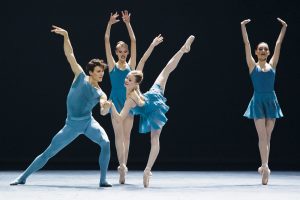Paris: Winter 2016 - Vancouver Ballet Society
- Home
- City Reports 2015 - 2019
- Paris: Winter 2016

by François Fargue
The Paris dance season ended in July and started again in September in almost all-American mode. In July, we saw works by George Balanchine and Justin Peck at the Bastille, and a Forsythe evening at the Garnier, followed by New York City Ballet at Les étés de la danse festival housed at Théâtre du Châtelet. Then, in September, the Paris Opera Ballet season resumed with American Ballet Theatre in Alexei Ratmansky’s Sleeping Beauty.
The end of last season at the Paris Opera also marked the definite departure of Benjamin Millepied, the most American Frenchman, from his position as the company’s artistic director. And, as it so happened, also the departure of William Forsythe as resident choreographer (appointed by Millepied). Forsythe, the most European of American choreographers, had kept a totally low profile throughout the season until that evening in July, which was made up of three of his works, including an enigmatic duo with a prophetically obscure title Of Any If And, created in 1995, and Approximate Sonata from 1996.
The highlight of the evening was the premiere of Blake Works to music by James Blake, created mostly for the younger dancers of the company. This is Forsythe going back to his roots as a creator of dance that takes both gall and glee to perform, and gives as much in return. Some of those young dancers showed particular brilliance, turning this invigorating piece into a radiant sign of what the future holds for the company; François Alu, Léonore Baulac and the very young Pablo Legasa (to name but three) were at the top of their art.
The Balanchine/Peck program running simultaneously at the Bastille struck a less convincing chord. Balanchine’s Brahms-Schönberg Quartet is an odd medley of styles, and Peck’s Entre Chien et Loup (literally, between dog and wolf, meaning dusk in French) demonstrates some of his savvy symmetries, but did not quite equal his In Creases shown previously. Peck is no doubt an artful maker of dance, but his pieces remain tamely playful and lack a decisive soul.
By most accounts, New York City Ballet conquered all, though I was not so taken by the one program I caught, which left many others that evening disappointed as well. Robert Fairchild, for all his sex appeal, lacked the distinction of a Greek god in Balanchine’s Apollo. And the dancers that night in his Four Temperaments did not deliver the lustre expected in a company specializing in Mr. B. An exception was the sculptural Chase Finlay in Duo Concertant: she is a compelling dancer and able to transcend the somewhat artificial pattern of the ballet.
The most-hyped event in September was the return of American Ballet Theatre to the Garnier after some 20 years. It is a pity they only came with Ratmansky’s minute reconstruction of Sleeping Beauty in 19th-century style, which proved technically restrictive as far the prince’s role is concerned. And even for the women. Ballerinas back then wore demure tutus onstage and never raised a leg higher than the hip. No six o’clock arabesques, as are par for the course in ballet today; instead, much emphasis is laid on petite batterie and speed of execution, which led to some less than pointed feet.
Sets and costumes were true to the fashion of the times, and were on the quaint and kitschy side, with some fetching costumes here and there. The general mood was of a dark and at times ominous fairy tale.
One of the highlights of the evening was seeing Daniil Simkin — though he is a regular performer at galas here — and Misty Copeland, who everyone had heard about but many hadn’t had a chance to see onstage until now. The pair triumphed in the Blue Bird variations, to which were added variations by Cinderella and Little Red Riding Hood, making the fairy tale cast of characters complete, though neither boasted much choreographic allure.
As Aurora, soloist Cassandra Trenary delivered quicksilver petite batterie with exquisite style and a perennial smile. Her prince, principal James Whiteside, does look the part, but merely mimed his way through in what now appears an antiquated fashion with no redeeming bravura at the end, save a diagonal of petite batterie; this may be a technical feat, yet lacks the excitement of high jumps. But then there was a fight back then yet to be won for men to be given as much pride of place on a ballet stage as the women.
As reconstructions go, Ratmansky’s Sleeping Beauty is certainly a fine and meticulous affair. Created in 2014, he strived indeed to recreate the original ballet from Stepanov notation, a choreographic score from the early 20th century. As a piece of ballet entertainment today, it looks a bit sentimental and tame. A pity we were not given the chance to see American Ballet Theatre dancers in some pithier stuff.

